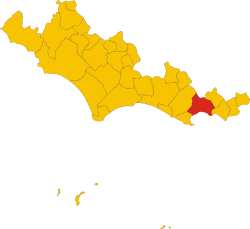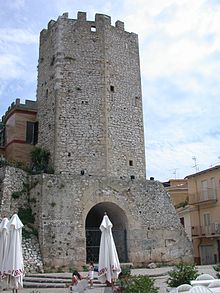Formia
Formia | |
|---|---|
| Comune di Formia | |
 Coat of arms | |
 Formia within the Province of Latina | |
show Location of Formia | |
 Formia Location of Formia in Italy | |
| Coordinates: 41°16′N 13°37′E / 41.267°N 13.617°E | |
| Country | Italy |
| Region | Lazio |
| Province | Latina (LT) |
| Frazioni | Castellonorato, Gianola-Santo Janni, Marànola, Penitro, Trivio |
| Government | |
| • Mayor | Paola Villa |
| Area | |
| • Total | 73 km2 (28 sq mi) |
| Elevation | 19 m (62 ft) |
| Population (31 August 2017)[2] | |
| • Total | 38,095 |
| • Density | 520/km2 (1,400/sq mi) |
| Demonym(s) | Formiani |
| Time zone | UTC+1 (CET) |
| • Summer (DST) | UTC+2 (CEST) |
| Postal code | 04023 |
| Dialing code | 0771 |
| Patron saint | St. Erasmus and St. John |
| Saint day | June 2 and June 24 |
| Website | Official website |

Formia is a city and comune in the province of Latina, on the Mediterranean coast of Lazio, Italy. It is located halfway between Rome and Naples, and lies on the Roman-era Appian Way. It has a population of 38,095.[3]
History[]

Formia was founded in ancient times by the Lacones and named in Greek, Ὁρμίαι (hormiai, meaning "landing place") and later in early Latin, Ormiae. In the Roman Republic era it was called Formiae (derived from Hormia or Ormiai, for its excellent landing). It was a renowned resort during the imperial era.
Cicero was assassinated on the Appian Way outside the town in 43 BC, and his tomb remains a minor tourist destination. The city was also the seat of St. Erasmus's martyrdom, by being disemboweled around 303 AD, during the persecutions of Diocletian. St. Erasmus later also became known as Saint Elmo the patron saint of sailors. Paulinus of Nola and Therasia stopped at Formiae on their journey back to Nola after visiting Rome, Easter 408. There they read Augustine's letter 95 addressed to them.[4]
After the fall of the Western Roman Empire, the city was sacked by barbarians and the population moved to two distinct burghs on the nearby hill, which were under the rule of Gaeta. Charles II of Anjou built a fortress in the maritime burgh, Mola di Gaeta. The other burgh was known as Castellone, from the castle erected there in the mid-14th century by Onorato I Caetani, count of Fondi.
The two villages were united again in 1863 under the name of Formia. The reunited city was badly damaged in 1943–44 in bombing operations and the Battle of Anzio.[5]
Geography[]
Formia lies on the Tyrrhenian Sea, in southern Lazio, close to the town of Gaeta and next to the borders of Campania region.
The municipality borders with Esperia (FR), Gaeta, Itri, Minturno and Spigno Saturnia.[6] It counts the hamlets (frazioni) of Castellonorato, Gianola-Santo Janni, Marànola, Penitro and Trivio.
Main sights[]
The most famous monument of Formia is the mausoleum traditionally identified with the : it is a 24-metre-high (79 ft) tower on the old Appian Way, enclosed in a large, 83-by-68-metre (272 by 223 ft) funerary precinct.
Other sights include:
- Tower of Mola
- Tower of Castellone
- Roman cistern, one of the world's largest. Similar to the structures in Constantinople and in the Domitian's villa of Albano, it dates from the 1st century BC.
- Remains of the Villa of Mamurra, partly destroyed in 1943, and of Roman aqueducts and cryptoportici.
- Church of San Giovanni Battista e Lorenzo, known from 841. It was almost entirely destroyed during World War II. It houses a panel by Antoniazzo Romano (c. 1490)
- Church of "San Michele"
- Church of San Luca, known from the 15th century. It has a recently discovered crypt with frescoes of Episodes of the New Testament and Madonna del Latte.
- Renaissance monastery and church of Sant'Erasmo. It was erected on the alleged site of the saint's martyrdom.
- Archaeological Museum.
- Regional Park of Gianola and Mount of Scauri.
- Formia War Memorial, with the large bronze sculpture Sacraficio by Dora Ohlfsen-Bagge
Sport[]
Formia is the seat of the National Athletics School of the Italian National Olympic Committee, founded in 1955. Athletes such as Pietro Mennea and Giuseppe Gibilisco trained here. Formia is also a hub for cycling events of various types; road cycling and mountain biking All of which gives access to Parks in Gaeta and Formia; Parco Monte Orlando, Parco Regionale Riviera di Ulisse, Parco Naturale dei Monti Aurunci, and Tours to Rome via the Old Highway. Formia also has great water sports to enjoy; windsurfing and sailing.
Transportation[]
Formia itself is one of the most important transportation hub of southern Lazio. The Rome–Formia–Naples railway passes through Formia-Gaeta railway station, from which visitors and residents may travel by bus to Gaeta, Minturno, Spigno and other local towns.
Ferries and hydrofoils connect Formia to Ponza, Ischia and Ventotene.
Twin towns - sister cities[]
Formia is twinned with:[7]
 Ferrara, Italy
Ferrara, Italy Fleury-les-Aubrais, France, since 2004
Fleury-les-Aubrais, France, since 2004 Gračanica, Bosnia and Herzegovina
Gračanica, Bosnia and Herzegovina Haninge, Sweden
Haninge, Sweden Santeramo in Colle, Italy
Santeramo in Colle, Italy
Notable people[]
- Antonio Sicurezza (Santa Maria Capua Vetere, 25 February 1905 – Formia, 29 August 1979), painter
- Vittorio Foa (Turin, 18 September 1910 – Formia, 20 October 2008), politician
- Amadeo Bordiga (Ercolano, 13 June 1889 – Formia, 23 July 1970), politician, founder of the Italian Communist Party
See also[]
References[]
| Wikisource has the text of the 1911 Encyclopædia Britannica article Formia. |
- ^ "Superficie di Comuni Province e Regioni italiane al 9 ottobre 2011". Istat. Retrieved 16 March 2019.
- ^ "Popolazione Residente al 1° Gennaio 2018". Istat. Retrieved 16 March 2019.
- ^ (in Italian) Istat 2017
- ^ "CHURCH FATHERS: Letter 95 (St. Augustine)". www.newadvent.org. Retrieved 2019-10-03.
- ^ (in Italian) History of Formia Archived 2016-04-07 at the Wayback Machine
- ^ 41192 Formia on OpenStreetMap
- ^ "Città gemellate". welcometoformia.it (in Italian). Formia. Retrieved 2019-12-30.
External links[]
| Wikimedia Commons has media related to Formia. |
- Cities and towns in Lazio
- Municipalities of the Province of Latina
- Formia
- Coastal towns in Lazio


